Session 2: Cell Structure and Function Notes
Cell Structure and Function
Learning Objectives
Define a cell and describe its function as the smallest unit capable of performing life functions.
List and describe the functions of major organelles within cells.
Explain how cells are specialized according to function.
Describe the role of mitochondria in ATP production.
Compare and contrast DNA and RNA, as well as transcription and translation.
Describe the basic structure and function of the plasma membrane.
Describe the building blocks, general structures, and biological functions of carbohydrates, lipids, proteins, and nucleic acids.
Describe different methods of transport across the cell plasma membranes.
Describe the major fluid compartments in the body.
Define and describe diffusion and osmosis.
Describe the effects of hypertonic, isotonic, and hypotonic solutions on a cell.
Key Concept: Cell Structure & Function
Definition of Cell: The cell is the smallest unit that can perform life functions.
Refer to the video for more information: Biology: Cell Structure.
Cell Diversity
The cell is the smallest structural and functional living unit.
There are over 200 different types of human cells.
Cell types differ in:
Size
Shape
Subcellular components
Functions
Eukaryotic Cell Parts: Organelles
The cell contains various organelles each with specific functions:
Smooth Endoplasmic Reticulum (ER) (lipid metabolism, detoxification, and calcium storage)
Microtubules (
Microfilaments
Vesicle
Plasma membrane
Golgi complex
Cytosol
Peroxisome
Mitochondria
Free ribosome
Nuclear pore
Nucleus
Rough ER
Pair of centrioles in centrosome
Ribosomes (attached to rough ER)
Lysosome (waste breack down)
Generalized Cell
All cells share common structures and functions.
Plasma membrane: Flexible outer boundary.
Cytoplasm: Intracellular fluid containing organelles.
Nucleus: Control center containing DNA.
Cytoplasm
Located between the plasma membrane and the nucleus.
Cytosol: Water with solutes (protein, salts, sugars, etc.).
Organelles: Cell machinery suspended in the cytosol.
Nucleus
Genetic library with blueprints for nearly all cellular proteins.
Responds to signals that dictate the kind and amount of proteins to be made.
Nuclear Envelope
Double-membrane barrier containing pores.
Regulates the transport of molecules into and out of the nucleus.
Inner lining maintains the shape of the nucleus.
Outer layer is continuous with the Rough Endoplasmic Reticulum (contains ribosomes).
Cytoplasmic Organelles: Mitochondria
Double-membrane structure.
Converts energy into ATP via aerobic metabolism.
Contains:
Outer mitochondrial membrane
Inner mitochondrial membrane
Cristae
Matrix
Mitochondrial DNA
Ribosomes
Mitochondria and ATP Production
Aerobic conditions.
More energy is generated in these conditions than in anaerobic conditions.
Energy stored within ATP.
Used for:
Synthesis
Transport
Mechanical work
Stages of cellular respiration.
Cytoplasmic Organelles: Ribosomes
Site of protein synthesis (contain protein & RNA).
Links amino acids together to make proteins.
Proteins are either used in the cell to make cell structures or exported from the cell.
Cytoplasmic Organelles: Endoplasmic Reticulum (ER)
Two types:
Rough ER: Contains ribosomes.
Smooth ER
Endoplasmic Reticulum Details
Rough Endoplasmic Reticulum
Studded with ribosomes.
Synthesizes proteins, including plasma membrane integral proteins and phospholipids.
Smooth Endoplasmic Reticulum
Synthesizes lipids (steroid hormones).
Involved in lipid and cholesterol metabolism (liver cells).
Responsible for absorption, synthesis, and transport of fats (intestinal cells).
Stores and releases calcium (in skeletal and cardiac muscle).
Golgi Apparatus
Stacked and flattened membranous sacs.
Function: Modifies and packages proteins for internal or external use.
Also involved in the transport of lipids and lysosome formation.
Transport vessels from the endoplasmic reticulum fuse with the Golgi apparatus.
Golgi Apparatus: Protein Processing and Packaging
Protein-containing vesicles pinch off rough ER and migrate to fuse with membranes of the Golgi apparatus.
Proteins are modified within the Golgi compartments.
Proteins are then packaged within different vesicle types, depending on their ultimate destination.
Pathway A: Vesicle contents destined for exocytosis.
Secretory vesicle
Secretion by exocytosis
Pathway B: Vesicle membrane to be incorporated into plasma membrane.
Pathway C: Lysosome containing acid hydrolase enzymes.
Vesicle becomes lysosome

Lysosomes
Spherical bags containing digestive enzymes (acid hydrolases).
Digest bacteria, viruses, and toxins (intracellular digestion).
Degrade non-functional organelles.
Destroy cells in injured or non-useful tissue (autolysis).
Break down and release glycogen (glucose storage molecule).
Break down bone to release calcium.
Peroxisomes
Membranous sacs containing powerful oxidases and catalases to detoxify harmful or toxic substances.
Contain antioxidants that neutralize dangerous free radicals.
Cytoskeleton
An elaborate series of filaments and tubules that extend throughout the cytoplasm.
Cellular support: gives shape to the cell and resistance to deformation (stability), stabilizing the tissue.
Cellular Extensions
Cilia and Flagella
Cilia move substances across cell surfaces.
Flagella (longer) propel whole cells (tail of sperm).
Microvilli
Fingerlike extensions of the plasma membrane.
Increases surface area for absorption.
Cilia Details
Short, hair-like projections that extend from the surface of the cell.
Coordinated movement of numerous cilia on the surface of a cell ensures the steady movement of fluid along the cell’s surface
Examples: respiratory tract, cells that line the uterine tubes.
The Plasma Membrane & Neurons
Neurons
What is the function of a neuron?
What are the three function types of neurons? How would you describe each?
Dendrites and axons both communicate with the cell body (soma). How is the function of a dendrite different from an axon?
How is an efferent neuron different from an afferent neuron (direction of transmission and function)?
List at least 5 functions of glial cells
What is the function of the myelin sheath?
Which cells create the myelin sheath in the CNS? Which cells create the myelin sheath in the PNS?
Membrane Structure and Functions
Plasma membrane: Extremely thin layer that forms the outer boundary of every cell.
Encloses the intracellular contents.
Acts as a mechanical barrier.
Determines cell composition.
Controls entry of nutrients and molecules and exit of waste products.
Maintains differences in ion concentrations inside and outside the cell.
Lipid bilayer
ECF (water)
Polar heads (hydrophilic)
Nonpolar tails (hydrophobic)
ICF (water)
Phospholipid molecule
Head (negatively charged, polar, hydrophilic)
Choline
Phosphate group
Glycerol
Tails (uncharged, nonpolar, hydrophobic)
Fatty acids
Test Knowloge:
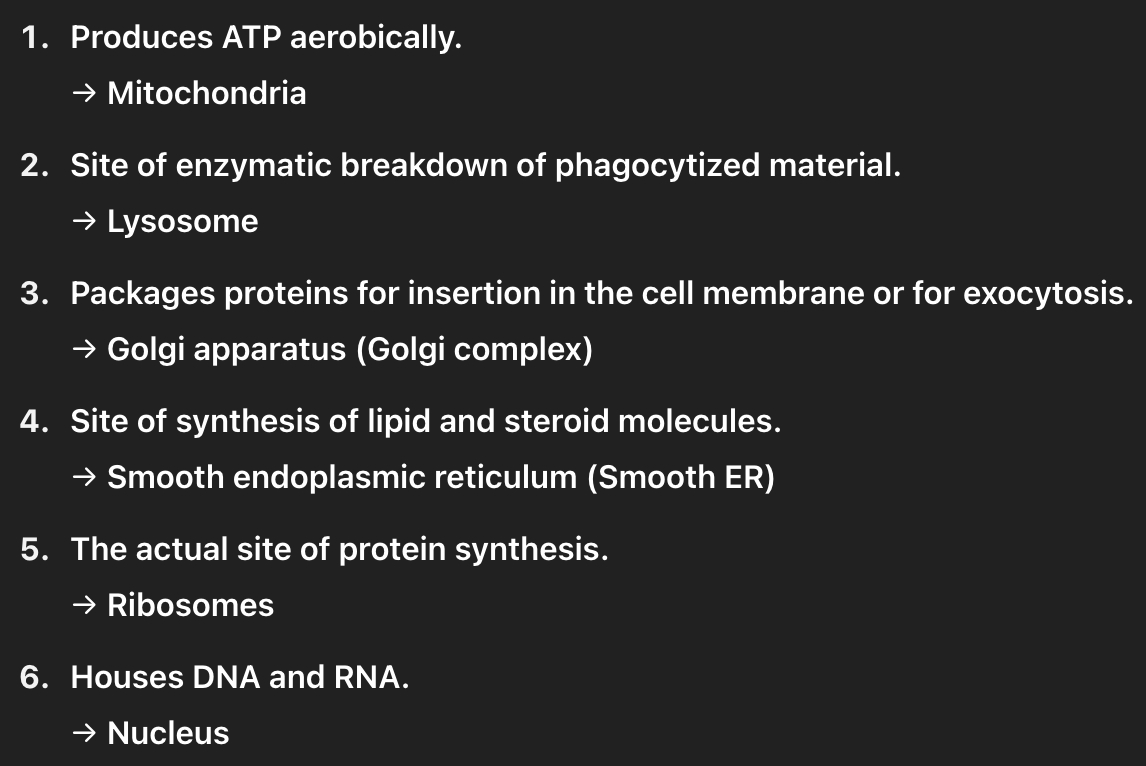
Plasma Membrane Components
Plasma membrane: extremely thin layer that forms the outer boundary of every cell
• Encloses the intracellular contents
• Acts as a mechanical barrier
• Determines cell composition
• Controls entry of nutrients and molecules and exit of waste products
• Maintains differences in ion concentrations inside and outside the cell
Lipid Bi-layer
Intracellular fluid
Extracellular fluid
Lipids
Proteins
Carbohydrates
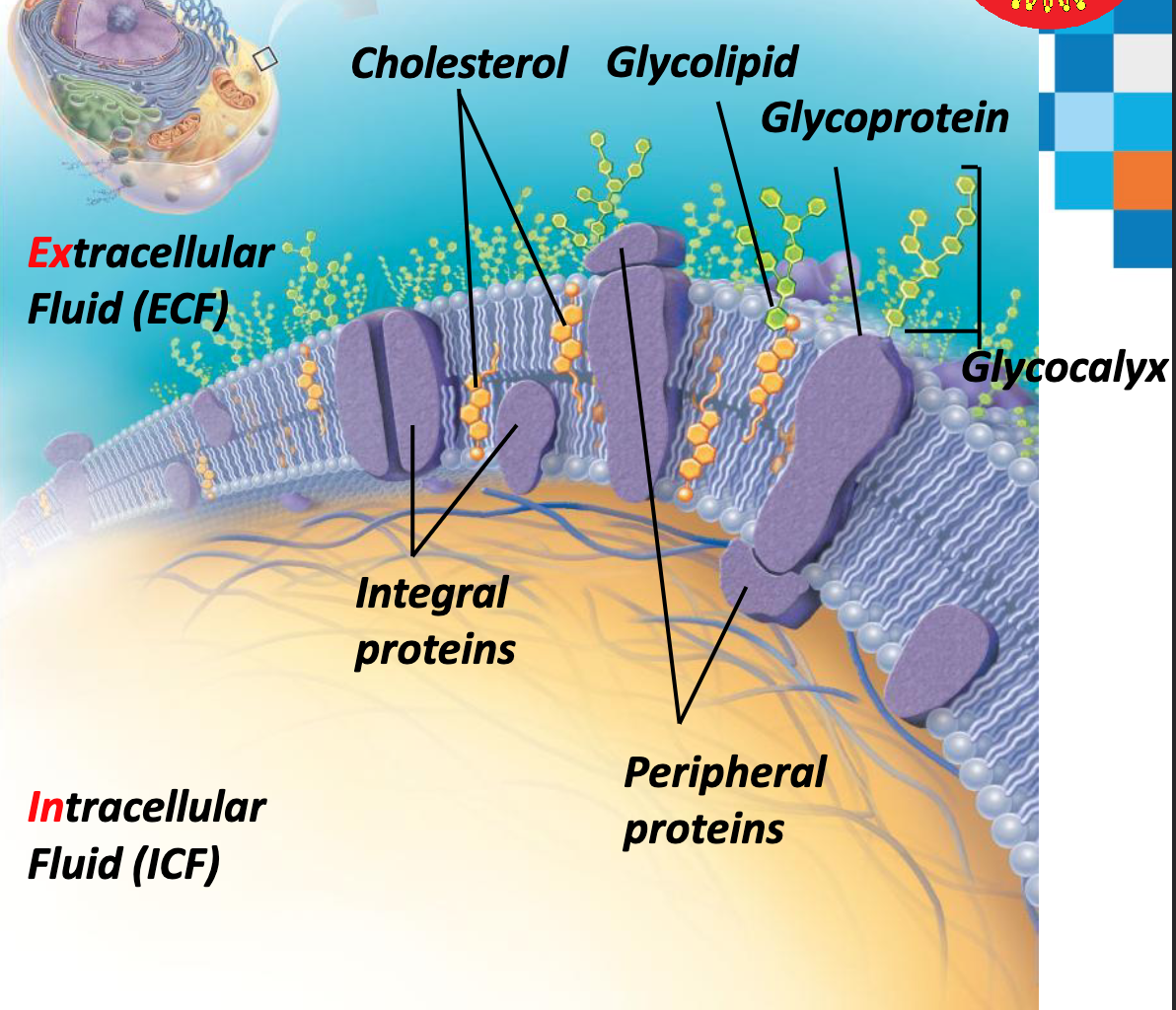
Function of Membrane Proteins
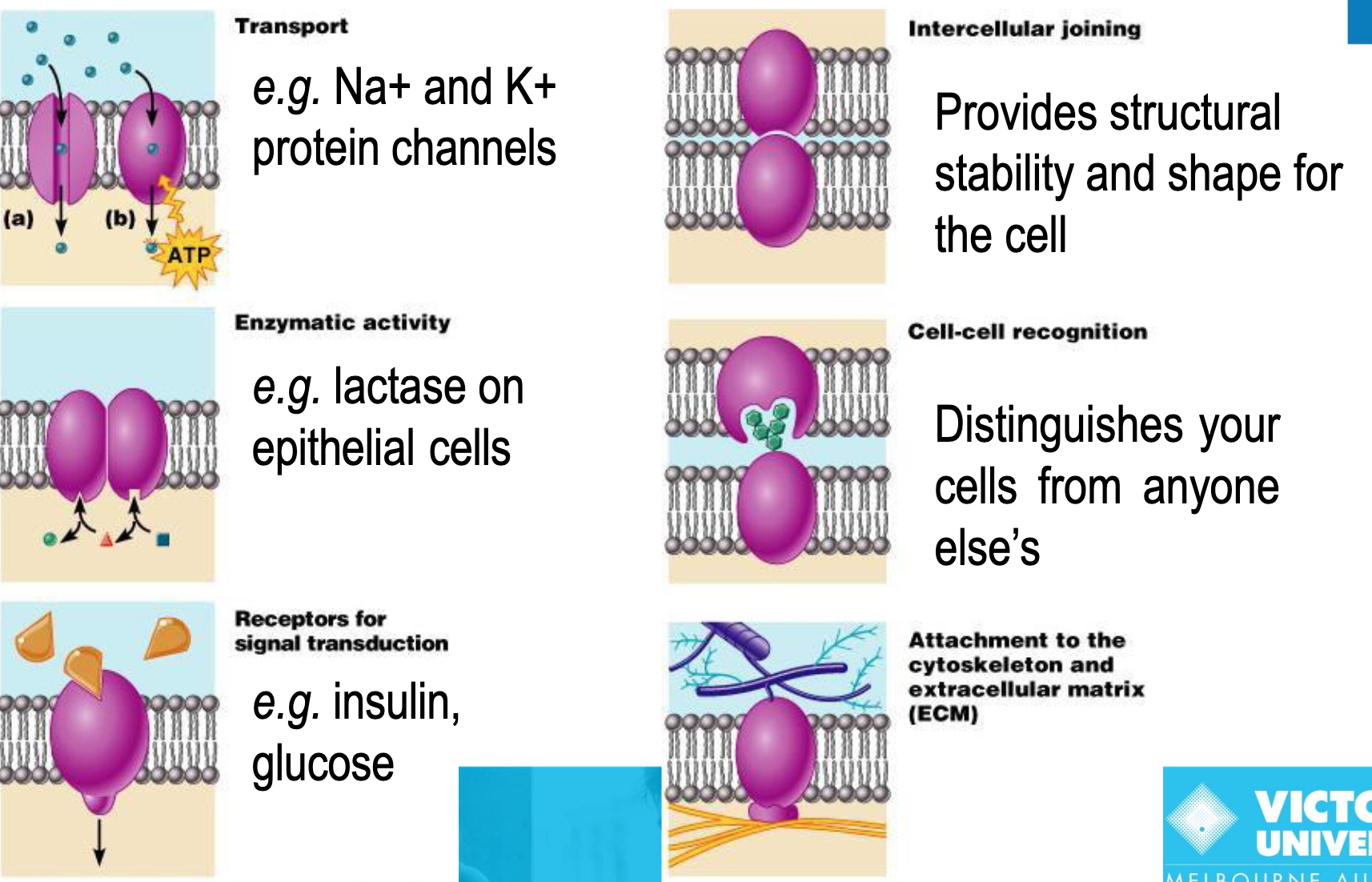
Fluid Compartments
Total body water = 40 L
Intracellular fluid (ICF) compartment: 2/3 or 25 L in cells
Extracellular fluid (ECF) compartment: 1/3 or 15 L
Plasma: 3 L
Interstitial fluid (IF): In spaces between cells
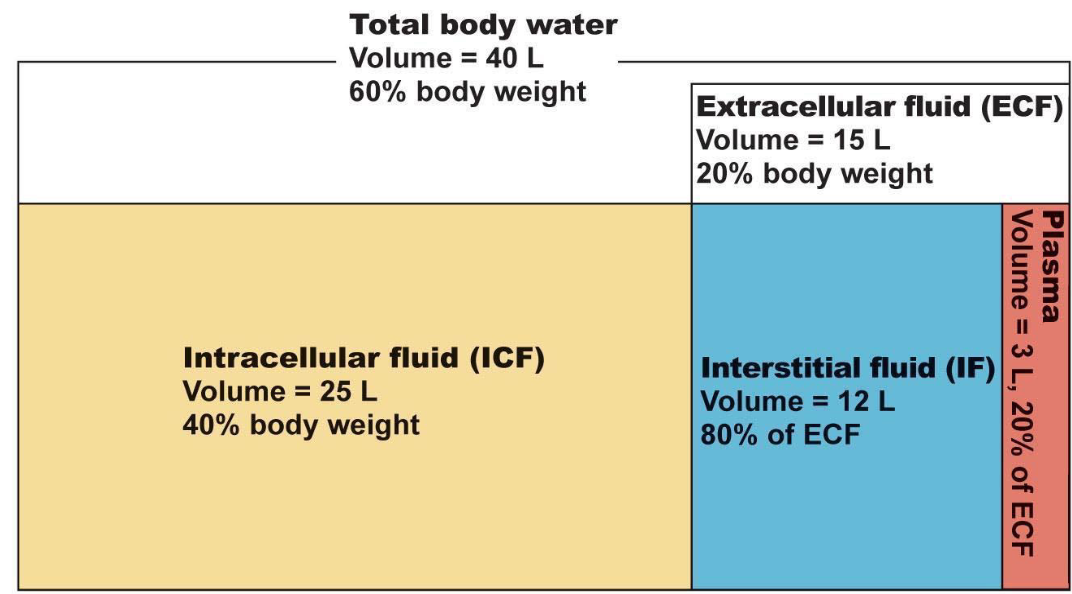
Fluid Compartments and Homeostasis
ECF is controlled by homeostasis through the:
Lungs (O2, CO2)
Gastrointestinal tract ( Nutrients, H_2O, Ions)
Kidneys (H_2O, Ions, Nitrogenous wastes)
ICF is controlled by the plasma membrane.
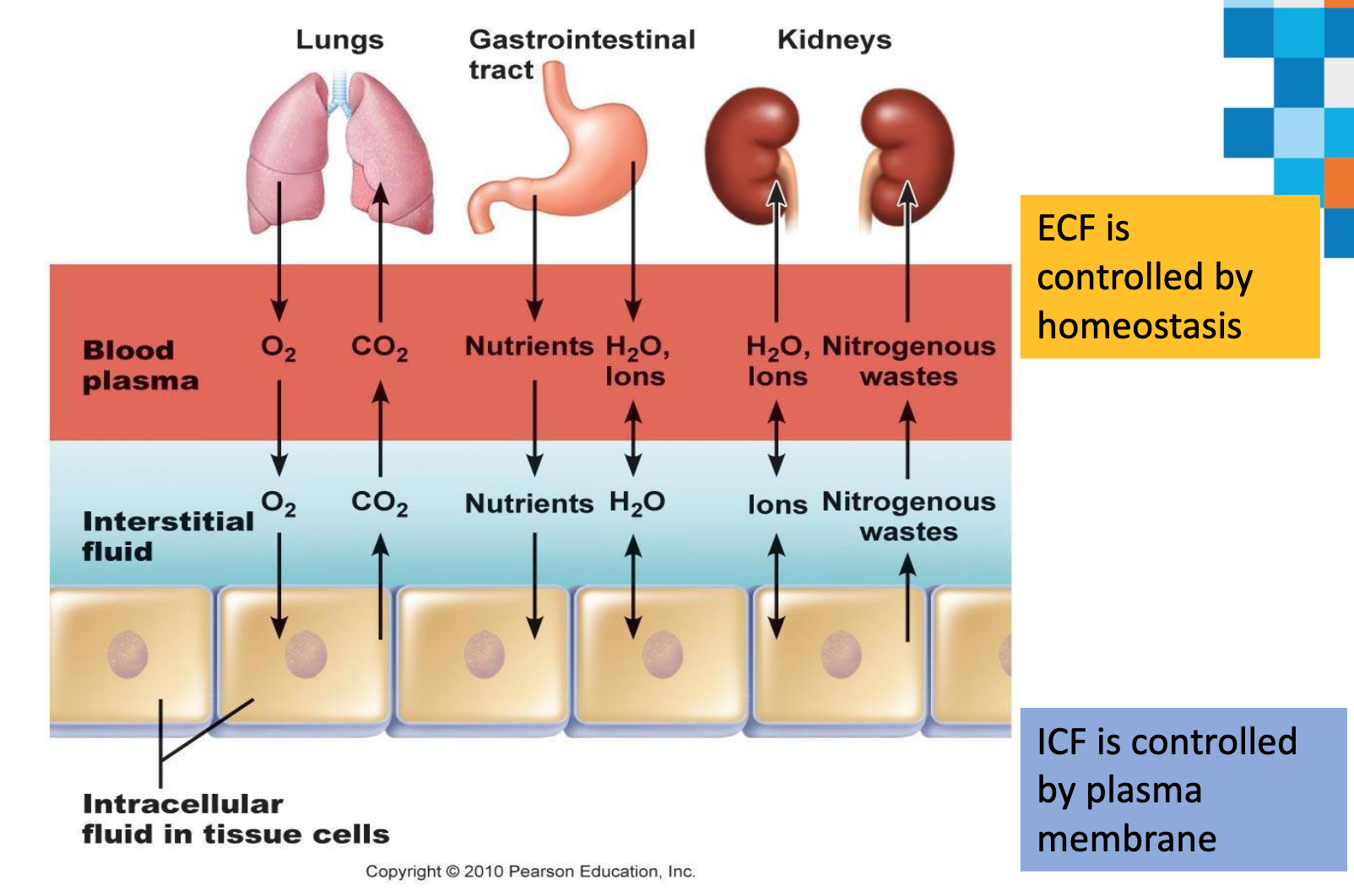
Membrane Transport
Plasma membranes are selectively permeable.
Some molecules easily pass through the membrane; others do not.
Passive processes (transport):
No cellular energy (ATP) required.
Substance moves down its concentration gradient.
Active processes (transport):
Energy (ATP) required.
Occurs only in living cell membranes.
General Rules for Membrane Transport
Lipid soluble molecules: fat soluble can cross by diffusion- e.g. alcohol, fat soluble vitamins, gases (carbon dioxide and oxygen).
Water soluble molecules: need channels (integral proteins)- e.g. glucose, amino acids – facilitated diffusion
Charged molecules such as ions: move through channels. e.g. sodium, potassium – passively down their concentration gradient or actively against their conc. gradient
Water: moves via aquaporins = osmosis
Passive Transport Processes
(a) Simple diffusion: of fat-soluble molecules directly through the phospholipid bilayer.
(b) Carrier-mediated facilitated diffusion: via a protein carrier specific for one chemical; binding of substrate causes shape change in transport protein.
(c) Channel-mediated facilitated diffusion: through a channel protein; mostly ions selected on basis of size and charge.
(d) Osmosis: diffusion of a solvent such as water through a specific channel protein (aquaporin) or through the lipid bilayer.
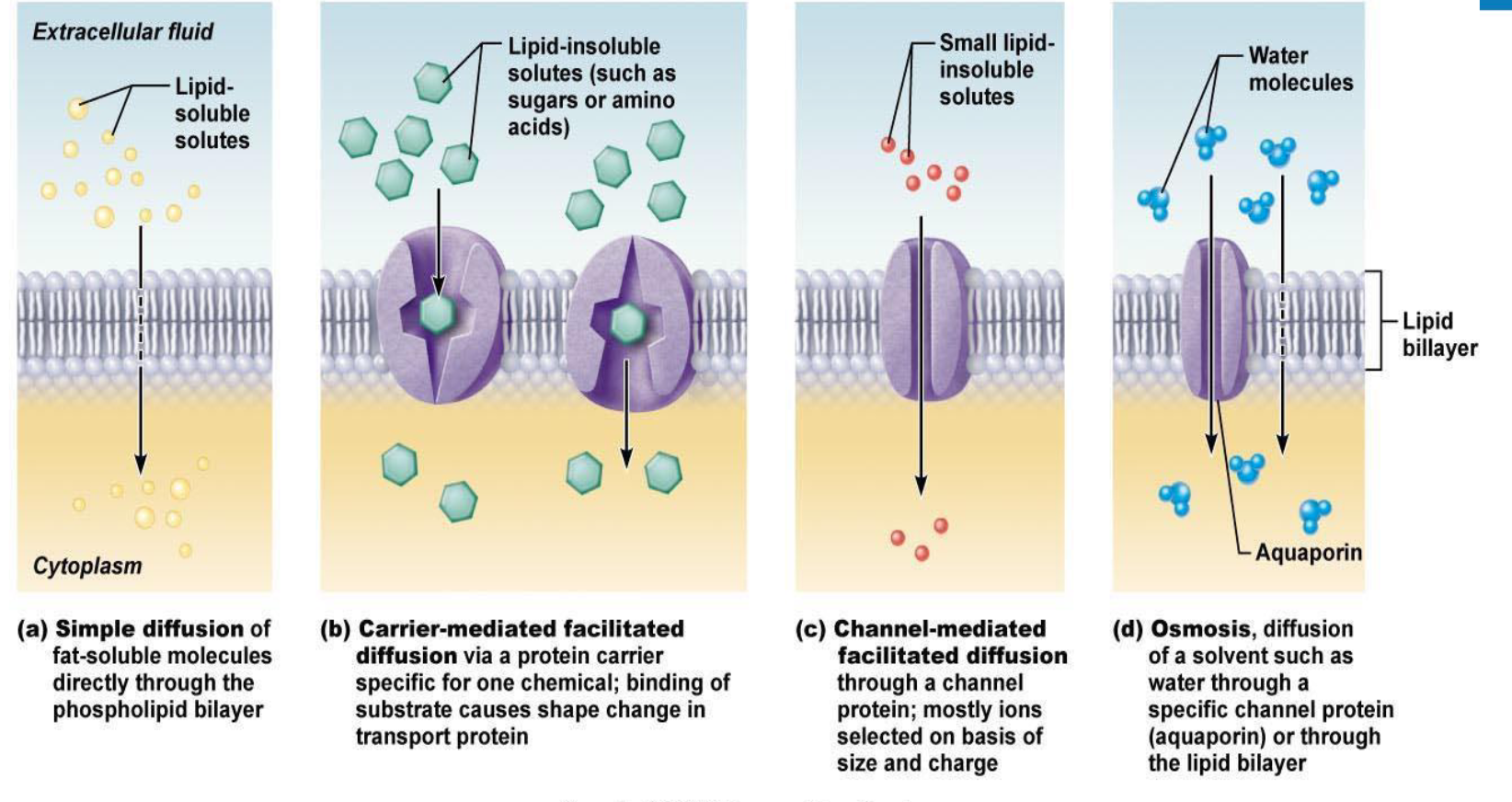
Diffusion
(a) Diffusion: Net diffusion = Diffusion from area A to area B minus diffusion from area B to area A
(b) Dynamic equilibrium : No net diffusion

Membrane Permeability and Diffusion
(a) Diffusion occurs: If a substance can permeate the membrane
(b) No diffusion occurs: If the membrane is impermeable to a substance
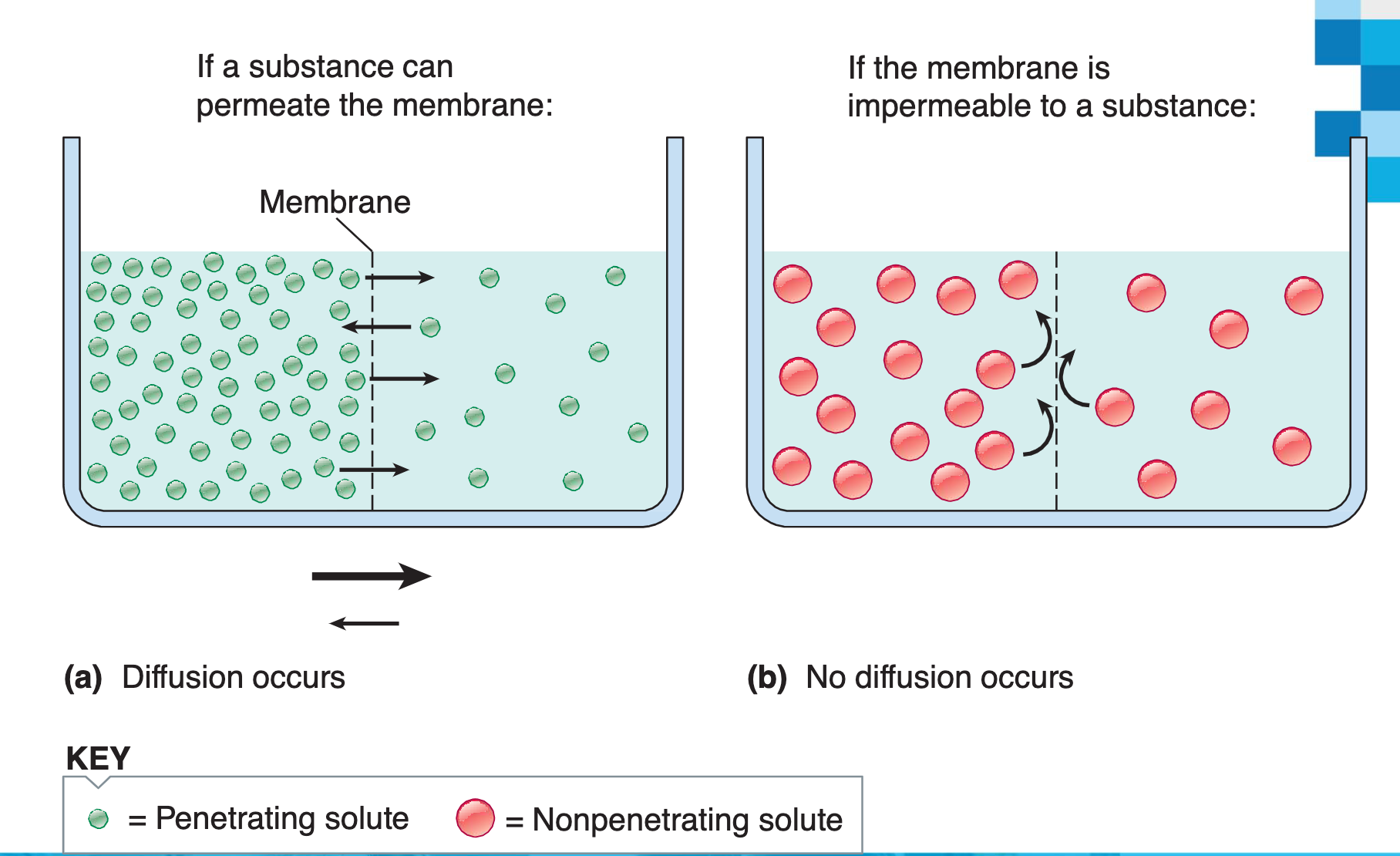
Passive Transport: Assisted Membrane Transport
Facilitated diffusion is passive carrier-mediated transport.
Uses a carrier to facilitate the transfer of a particular substance across the membrane “downhill” from high to low concentration
Facilitated Diffusion Mechanism
Carrier protein takes conformation in which solute binding site is exposed to region of higher concentration.
Solute molecule binds to carrier protein.
Carrier protein changes conformation so that binding site is exposed to region of lower concentration.
Transported solute is released and carrier protein returns to conformation in step 1.
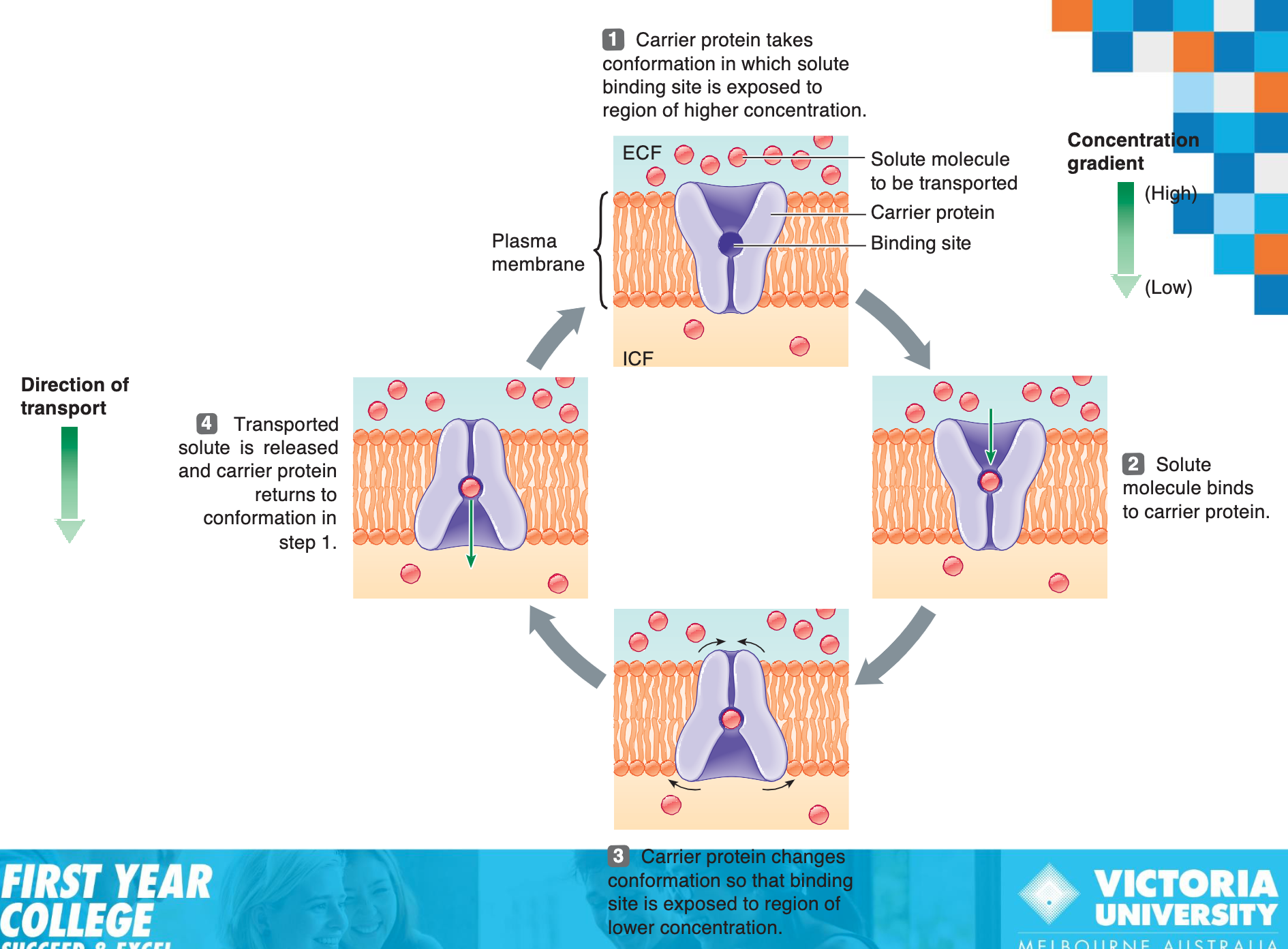
Passive Process: Osmosis (water solvent)
Osmosis is the net diffusion of water down its own concentration gradient.
When osmosis occurs, water enters or leaves a cell.
Osmolality: The measure of the total concentration of solute particles which can “hold” water.
When solutions of different osmolarity are separated by a membrane, osmosis (the movement of the water across membrane) occurs until equilibrium is reached (i.e. the same concentration of the solution is on both sides, but the volume is different- as osmosis moved water from one side of the membrane to the other)
Osmosis and Membrane Permeability
(a) Membrane permeable to both solutes and water: Solute and water molecules move down their concentration gradients in opposite directions. Fluid volume remains the same in both compartments.
(b) Membrane permeable to water, impermeable to solutes: Solute molecules are prevented from moving but water moves by osmosis. Volume increases in the compartment with the higher osmolarity.
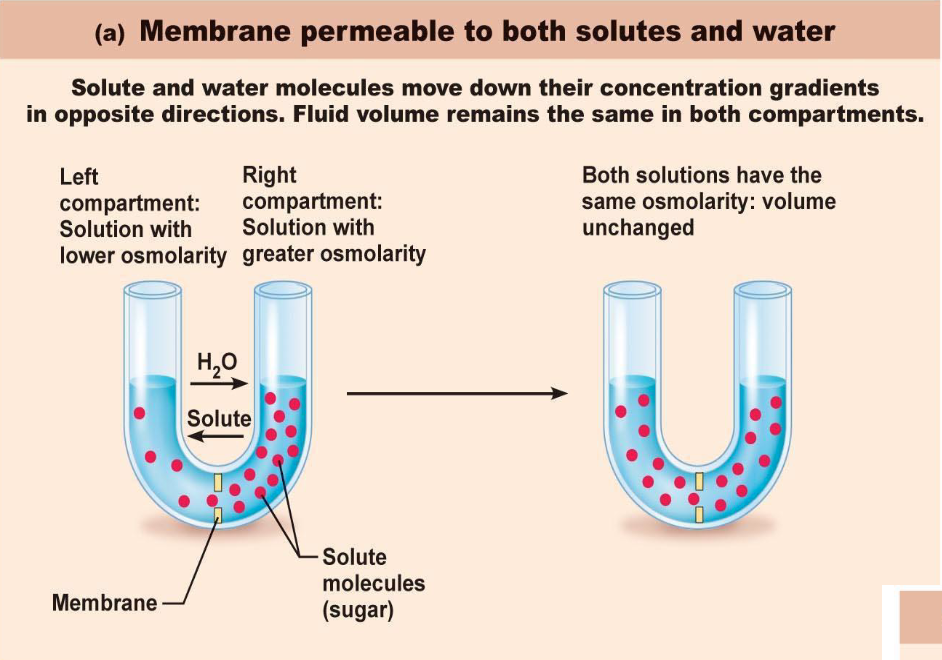
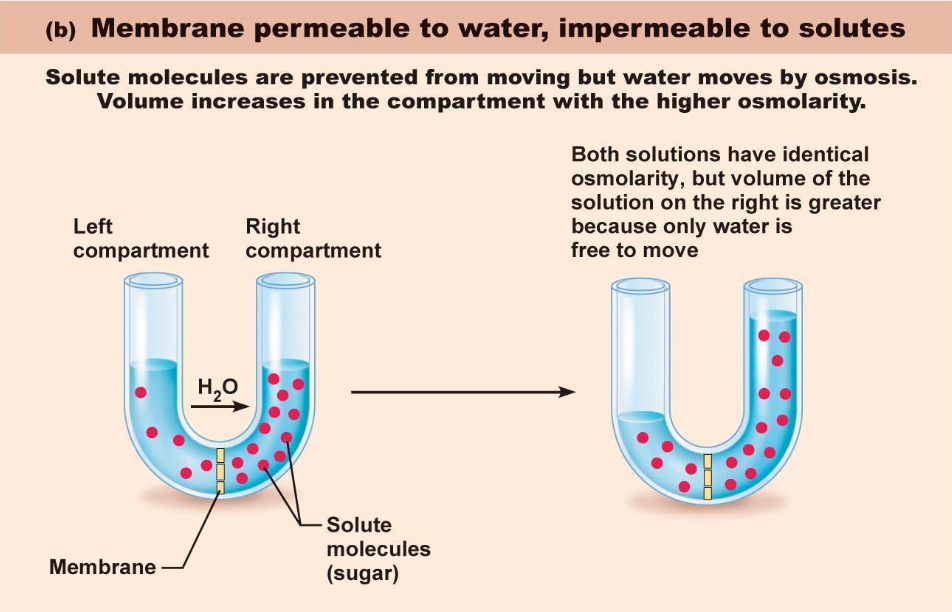
Importance of Osmosis and Tonicity
A change in cell volume disrupts cell function.
Tonicity: The ability of an extracellular solution to make water move into or out of a cell by osmosis. (e.g the ability of a solution to cause a cell to shrink or swell)
Isotonic: An extracellular solution with the same solute concentration as that of the cytosol (intracellular cytoplasm) will not result in water movement across the cell membrane.
Hypertonic: An extracellular solution having a greater solute concentration than that of the cytosol will cause movement of the water out of the cell (cell shrinks and dies).
Hypotonic: An extracellular solution having a lesser solute concentration than that of the cytosol will cause movement of the water into the cell (cell swells and ruptures= dies).
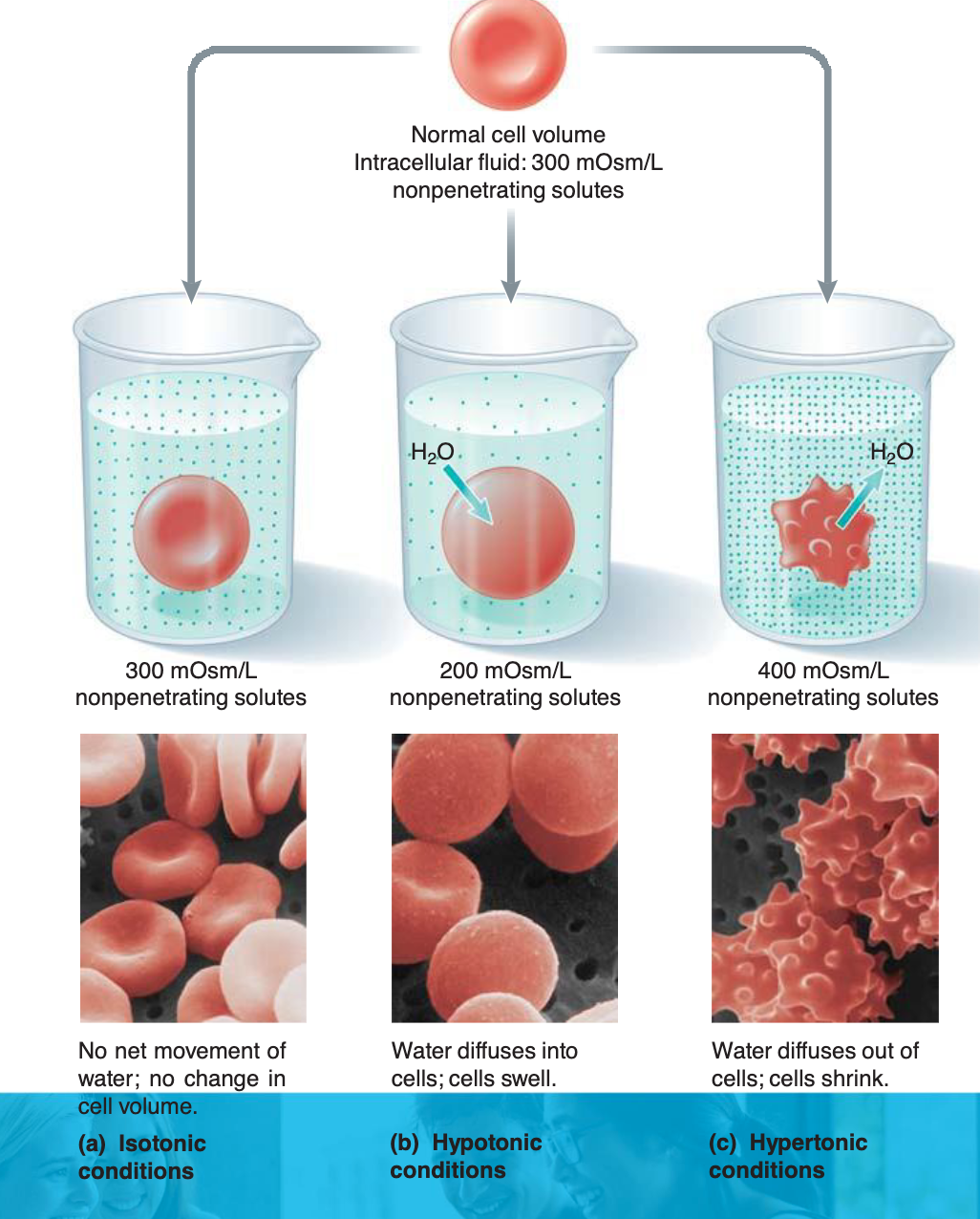
Effects of Tonicity on Cells
(a) Isotonic conditions: No net movement of water; no change in cell volume.
(b) Hypotonic conditions: Water diffuses into cells; cells swell.
(c) Hypertonic conditions: Water diffuses out of cells; cells shrink.
Membrane Transport: Active Processes
Active transport is carrier mediated and uses energy.
Primary and secondary active transport
There are two types of active processes both use ATP to move solutes across a living plasma membrane
Active transport: moves solutes against a concentration gradient and requires carrier proteins
Vesicular transport: transports large particles, macromolecules across plasma membranes
Vesicular Transport
Exocytosis: transport out of cell.
e.g. hormone secretion, neurotransmitter release, mucus secretion, ejection of wastes
Endocytosis: transport into cell.
Involve the formation of vesicles.
Often receptor mediated, therefore very selective.

Test Your Knowledge - Fill in the Gaps
Endocytosis is the method by which larger particles and macromolecules enter the cell by an infolding of the plasma membrane
Osmosis is the movement of water across a selectively permeable membrane
Exocytosis is the fusion of a vesicle with the plasma membrane to move substances out of the cell
Diffusion is the tendency of molecules to move along their concentration gradient from a region of high concentration to a region of low concentration.
Active methods depending on carrier proteins and energy
Specify the process by which the following would move across the plasma membrane:
a. Oxygen: Diffusion
b. Sodium ions passing from extracellular into intracellular fluid: Channel-mediated facilitated diffusion
c. Glucose: Facilitated diffusion
d. Sodium ions passing from intracellular fluid to extracellular fluid: Active transport
Which of the following cells is placed in the hypotonic solution. (Left/middle/right). Justify your answer.

Case Study: Water Intoxication
Negative Feedback Loop Example (Dehydration)
Increases Sodium concentration in plasma (↑osmolality) stimulates Osmoreceptors in the hypothalamus
Posterior pituitary releases Antidiuretic hormone (ADH)
ADH targets Collecting ducts of kidneys, increasing Water reabsorption
Results in scant urine
Plasma volume decreases, osmolality decreases
Building Blocks (Macromolecules)
Carbohydrates
Lipids
Proteins
Carbohydrates
Carbon (C) + hydrate (H2O) = (CH2O)
Supplies cell food
Examples:
Monosaccharides or simple sugars
Polysaccharides or polymers of simple sugars

Lipids
Diverse in chemical structures and play many important roles in our body.
Contain carbon, hydrogen and oxygen
Examples:
Neutral fats or triglycerides
Phospholipids
Steroids
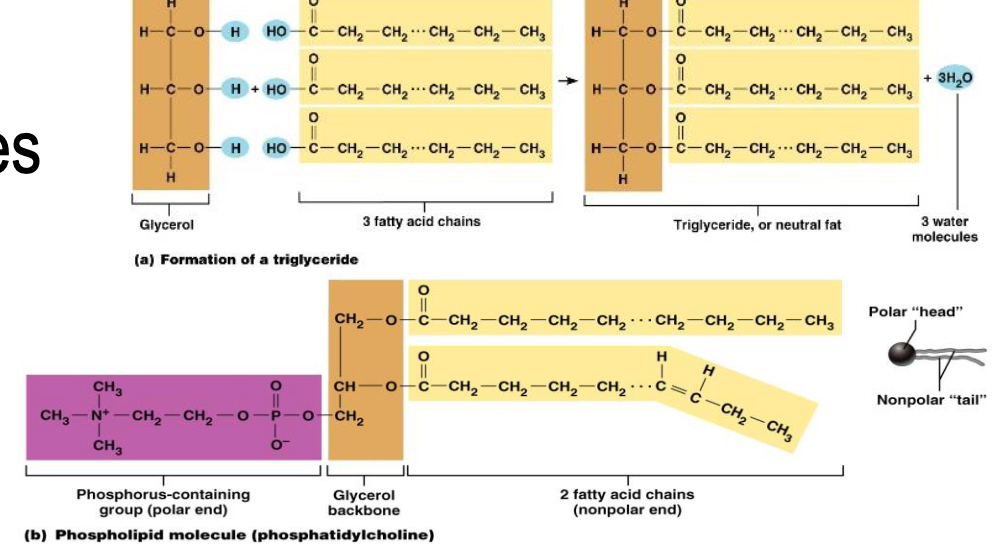
Representative Lipids Found in the Body
Neutral fats: found in subcutaneous tissue and around organs
Phospholipids: chief component of cell membranes
Steroids: cholesterol, bile salts, vitamin D, sex hormones, and adrenal cortical hormones
Fat-soluble vitamins: vitamins A, E, and K
Eicosanoids: prostaglandins
Lipoproteins: transport fatty acids and cholesterol in the bloodstream (LDL, HDL)
Amino Acids
Building blocks of protein containing an amino and carboxyl group
Amino group - NH_2
Carboxyl groups - COOH
R group = anything
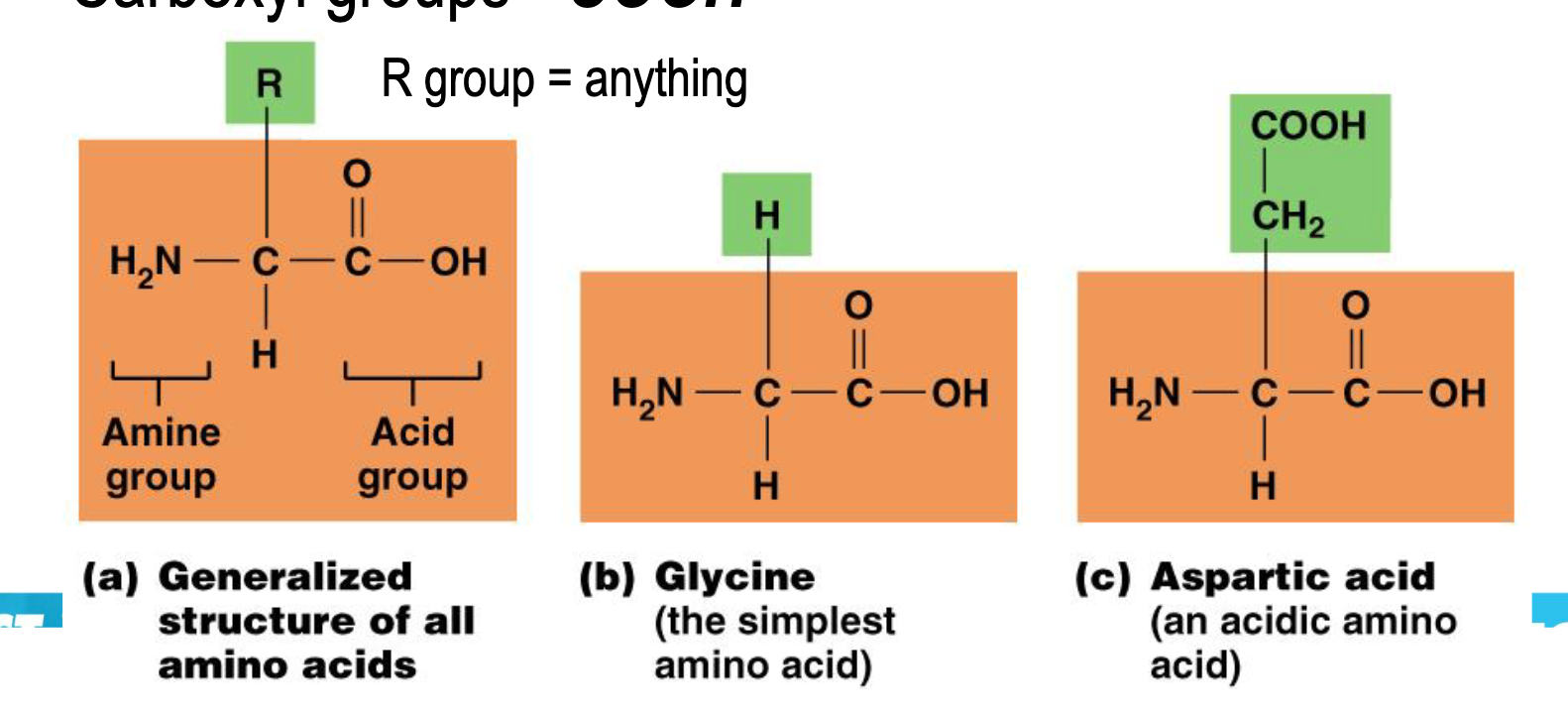
Proteins
Macromolecules composed of combinations of 20 types of amino acids bound together with peptide bonds
Dehydration synthesis
Amino acid + Amino acid = Dipeptide+ H_2O
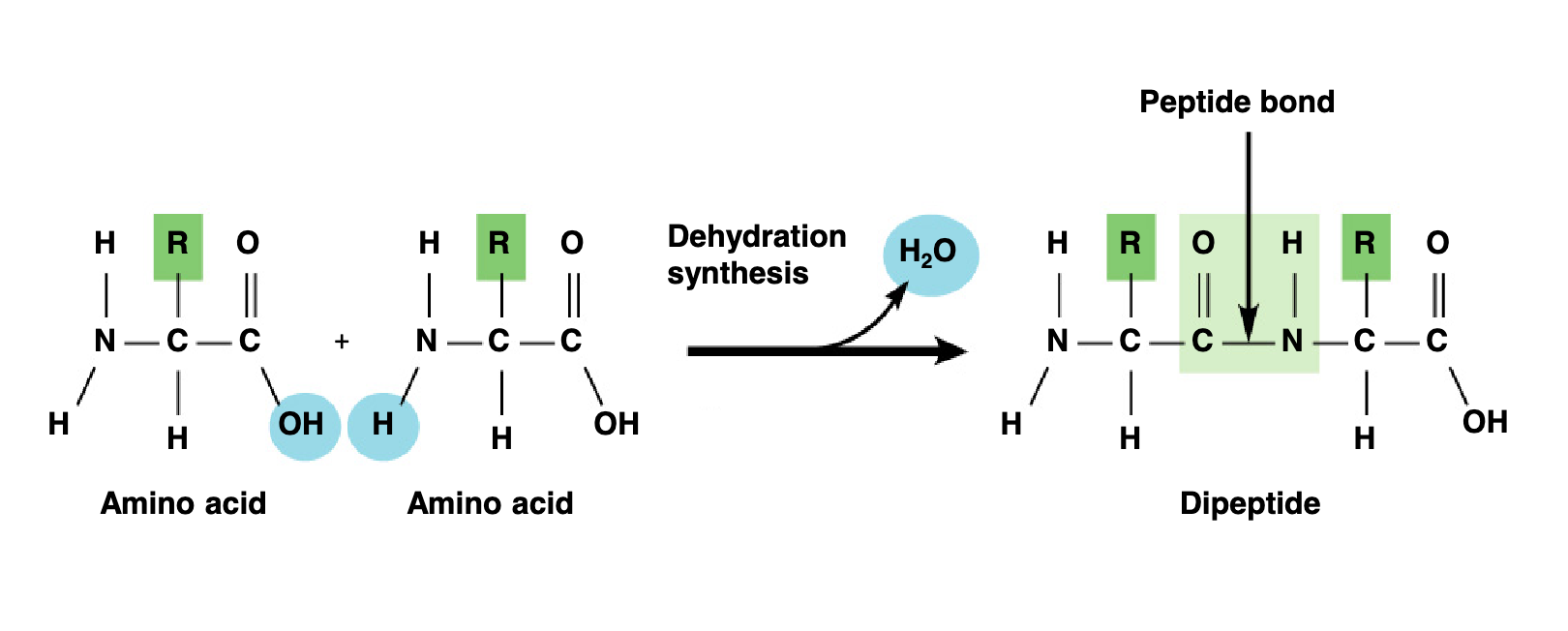
Protein Synthesis
DNA: Is the master blueprint for protein synthesis
Gene: Segment of DNA with blueprint for one polypeptide (protein)
Transcription: is the process by which the information in a strand of DNA is copied into a new molecule of messenger RNA (mRNA)
Translation: refers to the process of creating proteins from an mRNA template. The sequence of nucleotides on the RNA is translated into the amino acid
Ribosomes: Make (synthesize) proteins by linking amino acid to make a polypeptide chain

Protein Synthesis and Secretion
The rough ER synthesizes proteins to be secreted to the exterior or to be incorporated into plasma membrane or other cell components.
The smooth ER packages the secretory product into transport vesicles, which bud off and move to the Golgi complex.
The transport vesicles fuse with the Golgi complex, open up, and empty their contents into the closest Golgi sac.
The newly synthesized proteins from the ER travel by vesicular transport through the layers of the Golgi complex, which modifies the raw proteins into final form and sorts and directs the finished products to their final destination by varying their wrappers.
Secretory vesicles containing the finished protein products bud off the Golgi complex and remain in the cytosol, storing the products until signaled to empty.
On appropriate stimulation, the secretory vesicles fuse with the plasma membrane, open, and empty their contents to the cell’s exterior. Secretion has occurred by exocytosis, with the secretory products never having come into contact with the cytosol.
Lysosomes also bud from the Golgi complex.
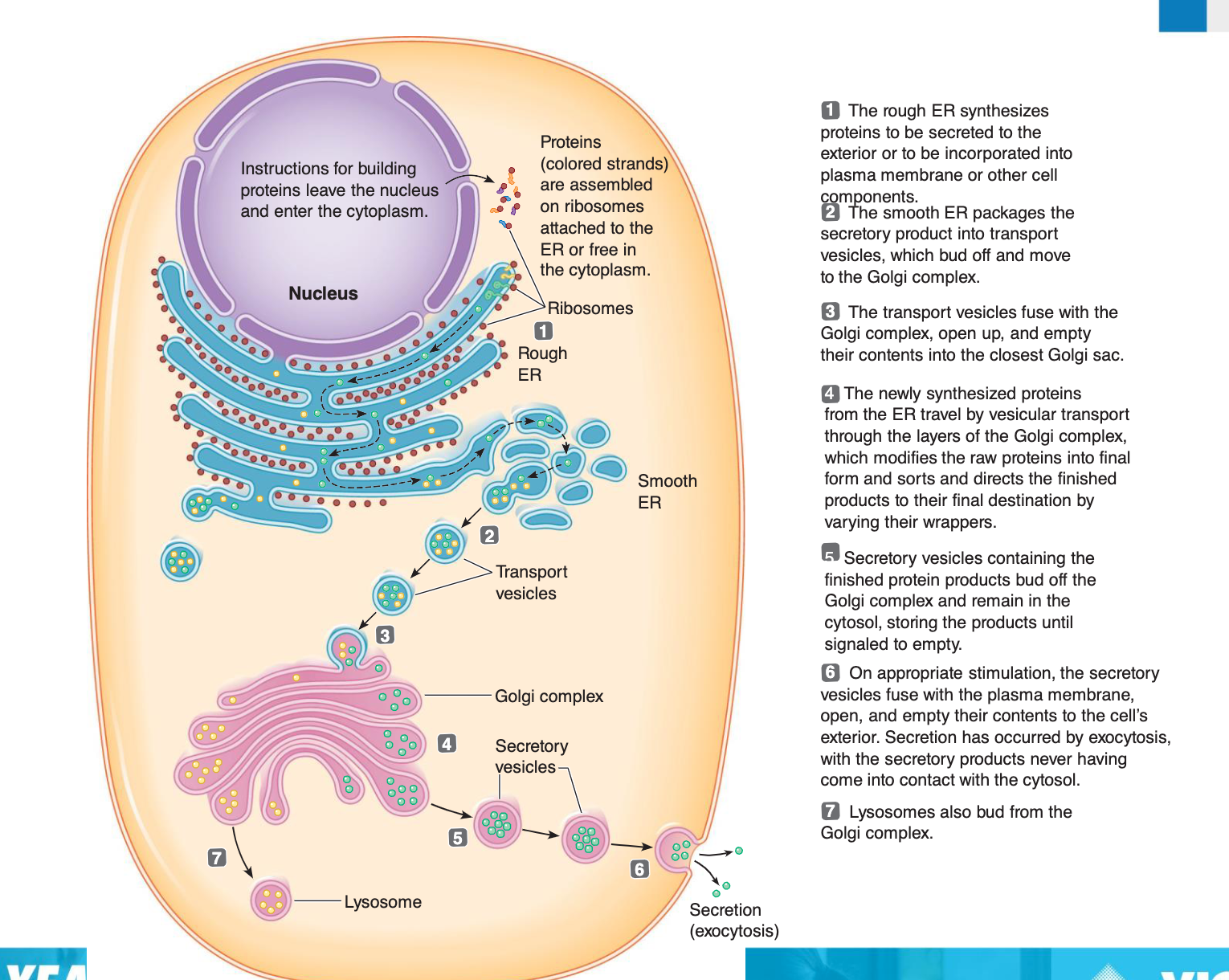
Structural Levels of Proteins
Primary: amino acid sequence
Secondary: alpha helices or beta pleated sheets (how it bends)
Tertiary: superimposed folding of secondary structures
Quaternary: polypeptide chains linked together in a specific manner (final big picture)
Examples of Proteins
Fibrous proteins: strand-like proteins
keratin, elastin, collagen
Globular proteins: tertiary and quaternary structures
antibodies, hormones, enzymes
Structure of DNA
Deoxyribonucleic Acid (DNA):
Double-stranded helical molecule found in the nucleus of the cell
Replicates itself before the cell divides, ensuring genetic continuity
Provides instructions for protein synthesis
Nucleic Acids
Their structural unit, the nucleotide, is composed of N-containing base, a pentose sugar, and a phosphate group
Five nitrogen bases contribute to nucleotide structure:
adenine (A)
guanine (G)
cytosine (C)
thymine (T)
uracil (U)
Two major classes: DNA and RNA
Composed of carbon, oxygen, hydrogen, nitrogen, and phosphorus
Ribonucleic Acid (RNA)
Single-stranded molecule found in both the nucleus and the cytoplasm of a cell
Uses the nitrogenous base uracil instead of thymine
Three varieties of RNA:
messenger RNA (mRNA)
transfer RNA (tRNA)
ribosomal RNA (rRNA)
Adenosine Triphosphate (ATP)
Source of immediately usable energy for the cell
Adenine-containing RNA nucleotide with three phosphate groups
Structure/Function | Organelle/Cell Part |
|---|---|
The sites of protein synthesis | Ribosomes |
The region inside the cell from the plasma membrane to the nucleus | Cytoplasm |
The organelle that manages or controls all the cell functions in a eukaryotic cell | Nucleus |
Digests excess or worn-out cell parts, food particles and invading viruses or bacteria | Lysosome |
Small bumps located on portions of the endoplasmic reticulum | Ribosomes |
Produces a usable form of energy for the cell – the powerhouse of the cell | Mitochondrion (or Mitochondria) |
Packages proteins for transport out of the cell | Golgi Apparatus (or Golgi Body) |
Consists of hollow tubes which provide support for the cell and gives the cell its shape | Cytoskeleton |
The part in the nucleus that is involved in protein synthesis | Nucleolus |
Small hair-like structures used for movement or sensing things | Cilia |
The membrane surrounding the cell, and is composed of a phospholipid bilayer | Plasma Membrane (or Cell Membrane) |
Longer whip-like structures used for movement | Flagella (or Flagellum, singular) |
Cell membrain
Function | Description |
|---|---|
1. Protection | Acts as a barrier, shielding the cell from its surroundings |
2. Selective Permeability | Controls what enters and exits the cell (nutrients in, waste out) |
3. Communication | Receptor proteins receive signals from other cells/environment |
4. Homeostasis Maintenance | Regulates internal conditions (e.g. ion and water balance) |
5. Structural Support | Anchors internal structures and connects with neighboring cells when needed |
General terms
Term | Definition |
|---|---|
Active Transport | Movement of substances across the cell membrane using energy (ATP), often against the concentration gradient. |
Semi-Permeable | Describes a membrane that allows some substances to pass through while blocking others. |
Cell Membrane | The outer boundary of a cell that controls what enters and exits; maintains homeostasis. |
Diffusion | The movement of molecules from high to low concentration without energy. |
Cyclosis | The movement of cytoplasm within a cell, helping transport materials. |
Osmosis | The diffusion of water through a semi-permeable membrane. |
Endocytosis | A process where the cell engulfs substances by folding its membrane inward. |
Exocytosis | A process where substances are released from the cell by a vesicle fusing with the membrane. |
Facilitated Diffusion | Passive transport where molecules move through transport proteins in the membrane. |
Homeostasis | The process of maintaining a stable internal environment within a cell or organism. |
Cell Structure | Location | Function |
|---|---|---|
Cell Membrane (Plasma Membrane) | External boundary of the cell | Confines cell contents; regulates entry and exit of materials |
Lysosome | Scattered throughout the cytoplasm | Digests worn-out organelles and foreign substances (cell "cleanup") |
Mitochondria | Scattered throughout the cell | Production of ATP (cellular energy) |
Microvilli | Projections of the plasma membrane | Increase the membrane surface area for absorption |
Golgi Apparatus | Near the nucleus | Modifies, sorts, and packages proteins and lipids for storage or transport |
Smooth Endoplasmic Reticulum (Smooth ER) | In cytoplasm, continuous with Rough ER | Synthesizes lipids and detoxifies substances |
Rough Endoplasmic Reticulum (Rough ER) | In cytoplasm, has ribosomes on surface | Synthesizes proteins for export and membrane insertion |
Ribosomes | Attached to Rough ER or free-floating in cytoplasm | Synthesizes proteins |
Cilia | Surface of certain cells | Act collectively to move substances across the cell surface in one direction |
Nucleus | Usually central in the cell | Controls cell activities; contains DNA |